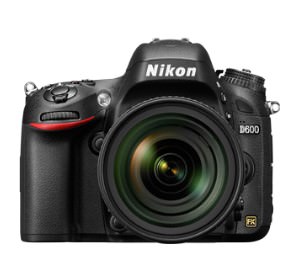Nikon has been holding its D600 DSLR cards close to the vest ever since the rumor mill started revealing possible details of this new camera. A significant speculative error was that the Nikon D600market would be for the entry-level DSLR camera buyer, competing with the recent Canon EOS Rebel 4Ti.


From a marketing perspective, Nikon has actually made a bigger play. Its August 12, 2012 announcement indicates that this new camera is for serious enthusiasts who’d love to have a Nikon D800 or Canon EOS 5D Mark III, but don’t have the deep pockets to purchase these pro-level, full-frame DSLRs. Although the Canon 5D Mark II could be an option, it’s been in the marketplace for more than 3 years and a number of its features and capabilities are falling behind newer models.
With the new D600, Nikon has somewhat magically transformed its FX format into a more compact, lighter camera body that will remind many of the D7000. Despite the D600’s smaller footprint, it houses a 24.3-MP CMOS sensor that Nikon claims was made specifically for its camera. This will certainly be appealing to the serious enthusiast market.
Although the D600 may be a smaller body, as a full-frame camera, it will give enthusiasts two advantages they probably haven’t had, or could hope to afford, that will allow them to take a giant step forward in creativity. A big sensor, such as in the D600, may have larger photosites (light receptors) per pixel at a specific resolution and that translates it outstanding photos. The other big-sensor advantage that will excite serious enthusiasts is the pro-quality depth-of-field they can achieve. They’ll discover that subjects will seem to leap from the frame, creating a greater three-dimensionality as well as a beautiful bokeh, or background blur, which is also a signature of professional’s photos.
Another benefit of the Nikon D600, as a full-frame, or FX format, DSLR is that Nikon DX lenses are compatible with this camera, which will automatically frame to the APS-C format. This is an important purchasing factor, especially if you are already shooting with a DX-format Nikon and have invested considerable dollars in DX lenses.
Autofocus System
The Nikon D600’s big sensor may capture and render the image with exceptional resolution, but it’s the fast, accurate autofocus system that will deliver the ultimate image and HD video sharpness. Greater creativity will certainly be a hallmark of the D600 because of its 39 focus points and wide-area AF coverage. Gain even more creative flexibility when shooting with telephoto lenses and teleconverters with the AF system’s 9 cross-type sensors and 7 center focus points, which perform excellently even to f/8. Switch to Live View, and stills and HD video are captured with stunning clarity because of the quality of the contrast-detect AF, which provides very precise fulltime autofocusing.
Versatile HD Video for the New Multimedia Artist
Professional photographers haven’t always responded positively to the video recording capabilities of their high-end DSLRs, but that has started to change in a big way, as more photographers are inspired to create in the multimedia form. Nikon has clearly recognized this trend and has packed the D600 with a full complement of video capabilities. Of course, they start with 1080p Full-HD with 30p, 25p or 24p frame rates and MPEG-4 AVC/H.264 compression. Other creative video tools include manual exposure control, fulltime AF with face-priority and subject tracking, dedicated inputs for a stereo mic and headphones, still-image exporting and many more. Plus, you’ll also have the same depth-of-field and bokeh control that will give your video an exceptional quality and mood.
Lighting Control and Wi-Fi Option
The Nikon D600 features a pop-up flash and an accessory shoe for use of the complete line of Nikon Speedlight Flash Systems. The camera is also fully compatible with Nikon’s i-TTL system, so the D600 can serve as a Commander and be your point of control of two groups of remote flashes across three channels.
Another feature trend that more consumers are expecting in new cameras, including high-value DSLRs, is Wi-Fi functionality. The D600 connects to the optional WU-1b Wireless Adapter, so you can offload photos to a smartphone, tablet or compatible devices. From there, you can easily share photos and videos via a Website, email and social media. For more creative versatility, add Nikon’s free Wireless Mobile Adapter Utility and your smartphone or tablet provides a remote camera view.
Specification Highlights
The Nikon D600 may look like a “little brother,” but it has a number of specifications that compare favorably with more expensive full-frame DSLRs.
- 24.3-MP CMOS sensor (same size as new Sony a99 and larger than Canon EOS 5D Mark II and III).
- 100–6,400 ISO range, expandable to 50–25,600 (same as Nikon D800/800E and Canon EOS 5D Mark II).
- 5.5 fps continuous shooting mode (faster than 5D Mark II; half-frame slower than 5D Mark III and Sony a99).
- Rated for 150,000 shutter cycles (same as 5D Mark II and III).
- 3.2-inch, 921,000-dot LCD (same as D800/800E; larger than 5D Mark II and a99).
- Wireless flash capability (Not available on 5D Mark II and Mark III and a99).
- Weight: 26.8 oz. (760g) (Weighs less than D800/800E and 5D Mark II and Mark III).
- MSRP: $2,099.95 ($700 less than a99; $900 less than D800; $400 less than 5D Mark II; $1,400 less than 5D Mark III).
The Nikon D600, full-frame DSLR (body only) is available for preorder from Amazon for $2,096.95
Photo © 2012 Nikon Inc
This article about Nikon D600 full frame DSLR camera was first published on our website here https://www.photographytalk.com/photography-equipment-reviews/2662-why-the-nikon-d600-full-frame-dslr-is-exciting-news-for-serious-enthusiasts
This article about Nikon D600 full frame DSLR camera was first published on our website here https://www.photographytalk.com/photography-equipment-reviews/2662-why-the-nikon-d600-full-frame-dslr-is-exciting-news-for-serious-enthusiasts